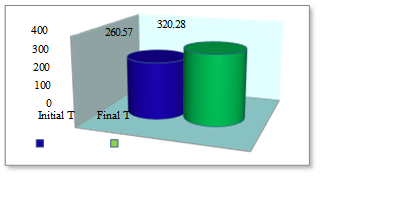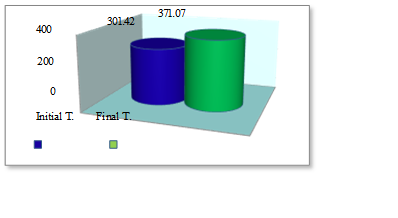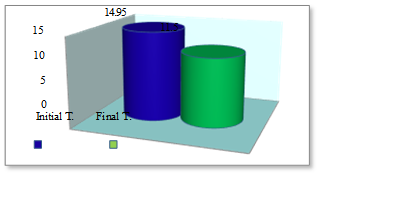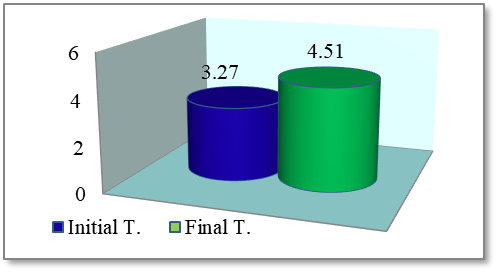Developing The Coordination Capacity Of The Polytechnic University Students Through Specialised Programs
Abstract
Coordination capacity is defined as being, first and foremost, an ability to quickly acquire new movements (the ability to learn quickly) and, second, an ability to quickly restructure the motor activity according to circumstances which change suddenly. Coordination is a motor quality with a wide applicability in both daily and sports activities, and we believe that this quality should be addressed with priority during the physical education and sports lessons in the technical higher education. The study carried out aims to orient the effort in the physical education and sports lesson towards the bio-psychomotor needs of the future engineer by implementing specialised programs, which have as a priority the development of coordination capacity. The experimental research was conducted between 01.10.2017 and 19.01.2018 on a sample of 70 students (male and female) from the Politehnica University of Bucharest. To determine the coordination capacity level, we used three tests in the initial and final phases of the experiment, namely the Matorin test for general coordination, the Hexagon test for agility – the speed coordination of the lower limbs – and the Bruininks-Oseretsky test for the upper-limb coordination (item 3). We found positive changes in the arithmetic means of the two tests (initial and final ones), the differences being statistically significant in the three tests investigated. The exercise programs which aimed at the coordination capacity development proved to be efficient for the students, having practical and applicative value, with possibilities to be used in the future profession through positive transfer.
Keywords: Coordination capacitiesmeansspecialised programsstudents
Introduction
Coordination capacity is defined as man’s ability to perform high-level motor coordination acts and actions in conditions of efficiency and with minimal energy and nervous consumption (Dragnea et al., 2006). Coordination regulates the ability to rationally execute various motor skills, regardless of the sports discipline approached (Bompa, 2008). It comprises the harmonisation of the nervous and musculoskeletal systems, resulting in a rapid, accurate and balanced motor response normally assessed by measurements of hand-eye or foot-eye coordination (Corbin, Pangrazi, & Franks, 2000). Agility relates to the ability of rapidly changing the position of the entire body in space with speed and accuracy (Fernandes et al., 2016).
Most authors consider coordination as a complex motor skill that is educated to improve abilities such as: the ability to adjust and direct single movements or actions involving the entire body, the ability to master the motor movement in any situation, as well as the ability to quickly move from some actions and relations to others, without interrupting the continuity and fluidity of motor acts and actions, in accordance with the ever-changing environmental requirements (Şerbănoiu, 2002)
Today’s professions, in general, and the engineering profession, in particular, whether it be mechanical, mechatronics, electronics, medical or aerospace engineering, are highly demanding jobs that require skills, talent, ambidexterity, space orientation, speed reaction, balance, almost everything that means motor coordination, because small mistakes can cause immense damage and can even lead to serious injuries.
Since coordination capacity is an aptitude with wide applicability in the sports and daily activity, and, as we have seen, in the professional one, it can be considered as a priority in the development of any individual.
Problem Statement
The issue of coordination capacity development is little known and explored at the level of young students in non-specialised higher education. Thus, most studies focus on the development of motor skills correlated with the state of health (Finichiu, 2012; Florescu, Pelin, Becea, Grigoroiu, & Neagu, 2016; Wesselly, Netolitzchi, Leonte, Braneț, & Popescu, 2018) or target the students of representative university teams (Răchită, 2016; Grigoroiu, Pelin, Wesselly, & Mezei, 2017). Physical education in technical universities aims, besides the formation of knowledge, at practical and intellectual skills, the acquisition of ethical values, the social integration of the individual and their professional development. The qualitative specificity of physical education does not consist in the fact that physical effort is being made, but in the objectives pursued, the way this activity is carried out and the emphasis placed on the formative value of the training content. One of the objectives of the Physical Education, Sports and Physical Therapy Department of the Politehnica University of Bucharest is to adapt the training content to the needs of the students, to enhance their learning outcomes and to help them acquire the skills specific to the profession they will practice. This idea is supported by Budde, Voelcker-Rehag, Pietrabyk-Kendziorra, Ribeiro and Tidow (2008), who have found that 10 minutes of acute bilateral coordination exercises promote more improvement in concentration and attention in learning than a normal physical education lesson with the same duration. They have also stated that coordination exercises involve an activation of the cerebellum, which, besides motor functions, influences a variety of neuro-behavioural systems including attention, working memory and verbal learning and memory.
The novelty of this paper is to address coordination capacity at the level of non-specialised higher education, so as to focus the effort on the priority needs of the students through means specific to physical education and sports, within the proposed coordination program. The program uses instruments borrowed from sports disciplines such as volleyball, athletics, aerobic gymnastics, which are ingeniously combined with various coordination-aiding materials such as: coordination ladder, targets, Boss semi-spheres, ropes, adjustable hurdles, balls of different sizes.
Research Questions
Is it possible to improve coordination capacity in young students by implementing the program using means borrowed from different sports branches?
Purpose of the Study
The aim of this paper is to orient the effort in the physical education and sports lesson towards the bio-psychomotor needs of the future engineer through the implementation of the program for the coordination capacity improvement, which combines means borrowed from sports disciplines with different aiding materials.
Research Methods
Subjects, place and strategy of the research
The investigated sample was made up of 70 subjects (girls and boys) aged 19-22, students at the Politehnica University of Bucharest (UPB). The research took place between 01.10.2017 and 19.01.2018 in the UPB Sports Complex. The selection process was random; The environment in which the study took place provided optimal conditions for carrying out the research. The research was conducted in two phases for each subject. The steps of the experiment are shown in Table
Over the course of 14 weeks, the experimental group performed the special program for the coordination capacity development during the physical education lessons, for 100 minutes/week. The means used during the lessons were both means borrowed from sports disciplines such as: aerobic gymnastics, volleyball, basketball, football, and exercises with diversified means such as: coordination ladder, hoops, targets, poles and cones, adjustable hurdles. The program of means was adapted to the level of the group and the needs of the engineering profession. We exemplify in Table
Didactic strategy. Materials: adjustable hurdles, coordination ladder, balls of different sizes, targets, hoops, Boss semi-spheres. Methods: demonstration, explanation, practice, conversation.
Research techniques used
The research instruments were represented by the following tests and assessments:
the Matorin test to determine general coordination (Horghidan, 1997);
the Hexagon test to determine agility – the speed coordination of the lower limbs;
the Bruininks-Oseretsky test (item 3, catch with both hands the ball thrown by the examiner – for visual-motor coordination), the test for the upper-limb coordination (Horghidan, 1997).
Research design
The research methods used to develop the pedagogical experiment are the following: bibliographic documentation, direct and indirect observation, experiment, testing and measurement, statistical and graphical methods (Epuran, 2005).
Findings
The dynamics of the results obtained during the experiment is shown in Table
Analysing by comparison the statistical indicators determined, we find that, in the Matorin Test with rotation to the left, the value of the arithmetic mean “
” is 260.570 at the initial testing and 320.280 at the final one (Figure

In the Matorin test with rotation to the right, the value of the arithmetic mean “
” is 301.420 at the initial testing and 371.070 at the final testing (Figure

In the Hexagon test, the value of the arithmetic mean “
” is 14.95 sec. at the initial testing and 11.50 sec. at the final testing (Figure

In the Bruininks-Oseretsky test, the value of the arithmetic mean “
” is 3.27 pts at the initial testing and 4.51 pts at the final testing (Figure

Conclusion
The analysis and interpretation of the experimental results regarding the level of the coordination capacity development reveals that the students have made progress in all three applied tests, which highlights the validity of the didactic strategy materialised by the efficiency and originality of the training programs implemented. The rationalisation and algorithmisation of the operational structures in the programs applied proved their effectiveness through the difference in the values of the results obtained at the initial and final testing after applying the tests for the coordination capacity assessment.
The program proposed for improving coordination capacity proved to be appropriate for the UPB students, the differences between the two testing phases being statistically significant for all three tests.
In terms of general coordination, with regard to the arithmetic mean of the group, the students progressed from the “satisfactory” score to the “good” score for the Matorin test on the left side and from the “good” score to the “very good” score for the one on the right side.
The students’ agility progressed from the “very good” score to the “excellent” score, and the coordination of both hands progressed from 3 points to 4.5 out of 5 possible.
The program was received with pleasure and interest by the students; we can say that it has made them adapt, find solutions, solve situations, become spontaneous and efficient, the skill being par excellence the quality of the nervous system to direct and refine the movements of our body in the most unexpected situations.
Acknowledgments
This work was funded by the Politehnica University of Bucharest through the “Excellence Research Grants” Program, Identifier: UPB-GEX 2017, Ctr. No. 97/2017 (POSOSTU).
All authors contributed equally to this study and should be considered as main authors.
References
- Bompa, T. O. (2008). Teoria și metodologia antrenamentului: Periodizarea (Ed. a III-a). Curtea de Argeș: Tana.
- Budde, H., Voelcker-Rehag, C., Pietrabyk-Kendziorra, S., Ribeiro, P., & Tidow, G. (2008). Acute coordinative exercise improves attentional performance in adolescents. Neuroscience Letters, 441(2), 219-223.
- Corbin, C. B., Pangrazi, R. P., & Franks, B. D. (2000). Definitions: Health, fitness, and physical activity. President’s Council on Physical Fitness and Sports Research Digest, 3(9), 1-11.
- Dragnea, A., Bota, A., Teodorescu, S., Stănescu, M., Șerbănoiu, S., & Tudor, V. (2006). Educație fizică și sport – Teorie și didactică. București: Fest.
- Epuran, M. (2005). Metodologia cercetării activităţilor corporale – Exerciţii fizice – Sport – Fitness (Ed. a II-a). Bucureşti: Fest.
- Fernandes, V. R., Scipião Ribeiro, M. L., Melo, T., de Tarso Maciel-Pinheiro, P., Guimarães, T. T., Araújo, N. B., … Deslandes, A. C. (2016). Motor coordination correlates with academic achievement and cognitive function in children. Frontiers in Psychology, 7: 318. https://dx.doi.org/10.3389/fpsyg.2016.00318
- Finichiu, M. (2012). The conditional motor capacities – Resistance and force during the university physical education class. Ovidius University Annals, Series Physical Education and Sport/Science, Movement and Health, XII(2 Suppl.), 406-410.
- Florescu, O., Pelin, R., Becea, L., Grigoroiu, C., & Neagu, N. (2016). Evaluation of the torso flexibility for the young population of Romania using Eurofit Test Battery for Adults. The 2nd Central and Eastern European LUMEN International Conference MEPDEV, Târgoviște, 17-18 November 2016 (pp. 122-125). Târgoviște: LUMEN.
- Grigoroiu, C., Pelin, R., Wesselly, T., & Mezei, M. (2017). Study on improving the segmental and plurisegmental coordination of the female students in the aerobic dance team of the University “Politehnica” of Bucharest. Marathon, 9(2), 163-171.
- Horghidan, V. (1997). Metode de psihodiagnostic. Bucureşti: Editura Didactică şi Pedagogică.
- Răchită, I. I. (2016). Developing the abdominal endurance of the UPB students by using means specific to judo in the physical education lessons. Marathon, 8(2), 254-259.
- Şerbănoiu, S. (2002). Capacităţile coordinative în sportul de performanţă. București: Afir.
- Wesselly, T., Netolitzchi, M., Leonte, N., Braneț, C., & Popescu, O. (2018). Assessment of upper body strength in the Romanian young population. The European Proceedings of Social & Behavioural Sciences, 36, 101-106. https://dx.doi.org/10.15405/epsbs.2018.03.13
Copyright information

This work is licensed under a Creative Commons Attribution-NonCommercial-NoDerivatives 4.0 International License.
About this article
Publication Date
16 February 2019
Article Doi
eBook ISBN
978-1-80296-054-9
Publisher
Future Academy
Volume
55
Print ISBN (optional)
-
Edition Number
1st Edition
Pages
1-752
Subjects
Sports, sport science, physical education
Cite this article as:
Wesselly, T., Grigoroiu, C., Mezei, M., & Netolitzchi, M. (2019). Developing The Coordination Capacity Of The Polytechnic University Students Through Specialised Programs. In V. Grigore, M. Stănescu, M. Stoicescu, & L. Popescu (Eds.), Education and Sports Science in the 21st Century, vol 55. European Proceedings of Social and Behavioural Sciences (pp. 239-246). Future Academy. https://doi.org/10.15405/epsbs.2019.02.30
